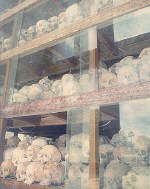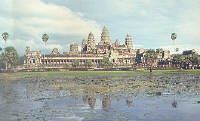Sawat dii everyone,
A colleague of mine in London has a sister who visited Bangkok in the early 70’s. She recalls that the town smelt overpoweringly of blossoms. Nowadays it smells mostly of smog and, like all of Asia, cooking.
To the traveler, the city appears to be a maze of dual carriageways, pedestrian fly-overs and traffic. Lots of traffic. Kao San Road, backpacker central, is a throbbing, flashing, heaving mass of neon,
house music, street stalls and…TOURISTS (‘scuse my French). A sort of oriental Tottenham Court Road.
In Chakraphong Road the street vendors do strange and, frankly disturbing things with ordinary foodstuffs. In Patpong, the persistent Go-Go girls (Hey, shy man! Me love you long time, okay?) do similarly worrying things with razor blades. In Ratchadamnoen Stadium, the band plays and the fenced crowds bay for blood while the contestants beat each other senseless in no-holds-barred Thai boxing.
In Phnom Penh you can visit the notorious S-21 prison where, between 1974 and 1978, Pol Pot’s Khmer Rouge imprisoned and tortured over 17,000 Cambodians and a handful of Westerners. This is not a sight for the squeamish. On display are examples of some of the primitive weapons of torture used as well as pictures of mutilated corpses and literally hundreds of snapshots of prisoners with the look of death in their eyes.
![]()
![]()
![]()


![]()
![]()
Fifteen kilometers outside town, on a dusty road, are the Killing Fields of Choeung Ek. This is where the S-21 prisoners were brought to be beaten and stabbed to death (so as not to waste any bullets) before being
buried in mass graves.
As if in a macabre condemnation from the Gods, rising waters exposed many of these graves and the victims remains had to be exhumed. All their skulls were collected and have been stacked in a surprisingly tasteful and poignant Stupa close to the graves.
Since conceiving this trip, Angkor Wat, along with the Three Gorges, Potala Palace, The Taj Mahal and Persepolis have constituted the backbone of my route.
![]()
![]()
![]()


![]()
![]()
The Angkor temple complex was built by a succession of Khmer Kings between the 9th and 13th centuries. Built, some would have us believe, around a plan reflecting the star sign Draco which was on the horizon in
the year 10,500 BC.
Graham Hancock’s theory about a lost civilization of bearded Astronomers who sailed the oceans in pre-history designing among other things, the Pyramids at Giza and the Mayan city of Chichen Itza, makes for fascinating viewing, but I confess that I am not convinced. His evidence is selective and his links at best, tenuous.
After the Siamese conquered the Khmers in the 13th century and sacked their city, they retreated to modern day Phnom Penh and Angkor was lost to the jungle until Henri Mouhot, a 19th century Indiana Jones, stumbled across it by mistake.
How the Cambodians managed to loose an entire city for five centuries is another matter. It just isn’t one of those things you loose every day, like say a pen or a toothbrush. Consider Bill and Hillary waking up one
morning. Bill stumbles into the White House bathroom grumbling…
“Darn it Hillary. Where did we put Houston again?”
“I don’t know, Bill. Did you look in Minnesota?”
The hundred or so temples, statues and buildings constituting the remains of the once great capital of the Khmer Empire encompass a total area of more than 15 square kilometers. This vast collection of Hindu and Buddhist structures is set within the grassy clearings of a sparse evergreen forest. The leafless tree trunks surrounding the temples soar thirty metres and more into the canopy. Their foliage filtering and dappling the sunlight onto the temples creating suitably jungle-like effect. The occasional flame-coloured orchid blazes like a rare gem among the ruins. At sunset bats fill the sky like flocks of birds. Their distinctive cries echoing off the sandstone and brick edifices as they must have done for centuries.
It costs $40 to gain entry to the Angkor site for three days, making it the most expensive tourist attraction I have ever seen. Unfortunately most of this money is disappearing into the back pockets of corrupt bureaucrats and the $800 million cost of the restoration works is being footed by the Japanese government under the auspices of UNESCO.
Perversely, after all this expensive restorative work, the most popular temple in the complex, apart from Angkor Wat itself, is Ta Phrom. The Buddhist temple that has been left exactly as it was discovered in the 1860’s: imprisoned in the jungle.
Huge pale coloured Spong trees grow in and around the buildings, crashing through walls and ceilings scattering bricks and tiles everywhere. Their enormous roots pooling on roofs and ledges before flowing viscously to the ground.
The land border between Cambodia and Thailand has only been opened to foreigners since February 1989. Before this, the Khmer Rouge used to delight in capturing, ransoming, and subsequently killing any foreigners audacious enough to try and cross it. To say that the road between Angkor and the border post at Poipet is bumpy would be like saying that Australians are occasionally a little outspoken. True, but
diplomatically put.
The current witticism with travel agents in Bangkok is that NASA practiced Moon landings on the road to Poipet. Yes, I thought it was funny too. Certainly the crater-like potholes are large enough to swallow cars up to half way up the doors and the 150 kilometer journey takes between eight and twelve hours to complete, depending on weather. If it rains heavily then the craters fill up with water and mud to the consistency of porridge and choosing your driving line becomes a bit of a lottery. Like stepping into a manhole filled with water and not knowing how far you are going to sink. Whether this road damage
is due to extensive land mining during the Cambodian civil war, or simply to decades of neglect is hard to tell.
Four months yesterday, since I began this trip. To celebrate I decided to institute some radical changes. First I changed my wardrobe, though this involved little more than two new T-shirts and a pair of trousers. I also tried to dye my hair, or what’s left of it, blonde. Unfortunately my Irish roots came through and my hair turned out orange. So now I look distinctly like the Orange Tango man.